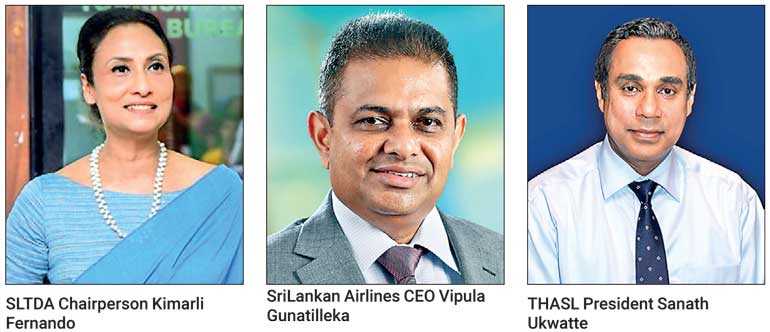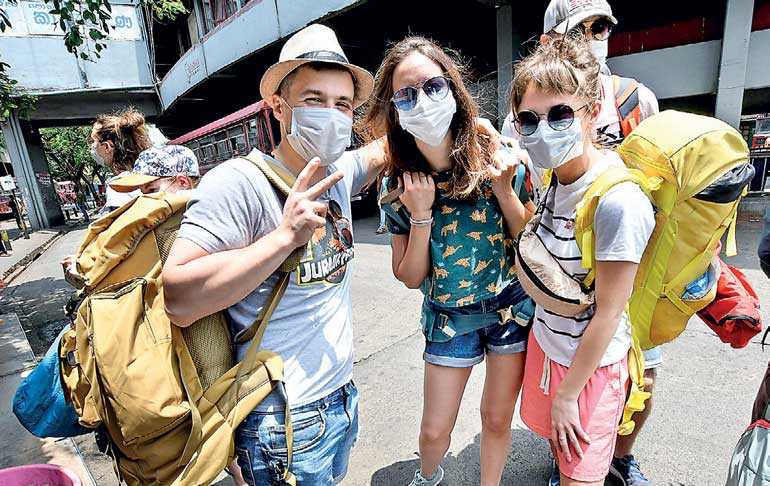Tuesday Dec 16, 2025
Tuesday Dec 16, 2025
Tuesday, 28 April 2020 00:00 - - {{hitsCtrl.values.hits}}


The tourism industry has been hard hit by the pandemic, and naturally would be looking for an early revival of travel and arrival numbers. But we must guard against acting too early
– Pic by Shehan Gunasekara
By Darshana Abayasingha
The world is at an important juncture in history. COVID-19 has ripped the fabric of life as we know it, but it also presents a unique opportunity to rewrite the future and our country’s position with the rest of the world.
A developing economy beset with balance of payments crises, burgeoning debt, socio-economic issues and widening cracks in its agriculture and manufacturing economy, Sri Lanka’s position is hardly enviable. In theory, we are now at a far more perilous state as key sectors including manufacturing, agriculture and tourism are at standstill, and the cogs of the domestic economy sit home under quarantine.
Three months from now, if authorities can sustain their excellent efforts and eliminate local cases of COVID-19, Sri Lanka is stepping onto a springboard to a new future as much of the world continues to grapple with the virus. To conquer constraints of fraught global supply chains or imports, local industries must reinvent the wheels at home and forge a vibrant and sustainable supply chain, explicitly in spheres of agriculture, food and manufacturing. Sri Lanka can!
As the saying goes: ‘Sometimes when things are falling apart, they may actually be falling into place’. Self-sustenance is no pipedream with precise motivation, direction, support and communication. It’s a regressive topic for the country due to impacts under the Bandaranaike regime, but then what of that duo was not retrograde or ill-conceived. In this present milieu of global turmoil, herein lies possible answers and opportunities.
Such an ambitious endeavour requires considerable planning, communication and a doctored distribution of resources. We must learn to ditch politics and commit every public and private resource to the task within a short and focused period. But if we could crack the whip and achieve this end within a year, we will slash our import bill considerably. Consequently, if we could expand volume staying true to our reputation for quality, Sri Lanka can aggressively take on export markets and establish a wider global footprint. Here’s a potential opportunity for Sri Lanka to set aside its balance of payments crises, burgeoning debt and socio-economic issues.
Notwithstanding controversies surrounding the spread of the virus, COVID-19 has eroded global confidence in China, which was the manufacturing hub of the world. Several economies will look to take advantage of the COVID-19 fallout, preceded by the US trade war with China in 2019. Vietnam will be a leading contender having excelled in controlling the spread of the virus despite a population of over 95 million. Bangladesh with over 161 million people, is reporting no more than 5,000 cases. These low-cost production hubs will be Sri Lanka’s competition. Sri Lanka can control the virus before these countries, and we need to get a head start with a plan. These plans have been in place for decades, gathering dust due to conflict and powerplays that put country behind self. Let’s get the ball rolling, at least now!
When to open the international airport
One of the biggest challenges for authorities would be the decision on when to open the international airport for passengers. This has the potential to undo all the good work that has been done here, and even in countries like Australia and New Zealand, which has seen drastic drops in infection numbers and imported cases as their airports remain shut. This would be a tough call to make. The tourism industry has been hard hit by the pandemic, and naturally would be looking for an early revival of travel and arrival numbers. But we must guard against acting too early.
Sri Lanka Tourism Development Authority Chairperson Kimarli Fernando shared her views during an online forum last week.
“It’s just a question of when? When will travellers be comfortable to fly and travel to a destination? When it does open up, I believe Sri Lanka would be looked at positively because of the progress that has been made (with COVID-19). Internally, we will make some changes and streamline things and automate. We need to relook at the act, the registration process and the classification of hotels. We have to add the COVID-19 element to the hotels.”
“We are creating guidelines on visas; the process will be changed. Everyone will need to have a test. This will be done in consultation with stakeholders and made part of the visa process. They will have to book accommodation before they come. There will be a checklist given to hotels on how to do things, and we want to ensure the safety of our staff, so they have a clean bill of health before going back to their village. So, a process will be done up, but we don’t know when the airport will be open.” Joining the discussion, SriLankan Airlines CEO Vipula Gunatilleka also underscored the importance of testing. Commenting on some of the instant checks done by other airlines he expressed doubts if these are done in a manner prescribed by the WHO. He expresses confidence a new mechanism to minimise risks would be put in place soon within prescribed guidelines, and predicts that tourism would only return to normal in Q2 of next year.
“We have to reinvest our business models and bypass intermediaries, which will happen in tourism also. Majority of our main markets we don’t know the real magnitude of infections like in India. So, we have a major challenge there. New opportunities may come from North Asia and we hope Australia will bounce back. We will closely monitor these. The situation is changing fast and what is right today may not apply next week,” Gunatilleka adds.
Tourism was a top foreign exchange earner for Sri Lanka, and a prolonged shutdown spells a nightmare two years for the industry. The sector was just picking up after setbacks from the Easter attack last year before COVID-19 wreaked havoc. The Easter attack demonstrated for the first time the length and breadth of the tourism value chain in our country. Its revival must adopt a bold and aggressive strategy similar to the ideas envisaged above. The industry must be pushed towards quality over quantity, and a holistic mechanism developed to inculcate the value chain into the process.
SLTA Chairperson Fernando elaborated: “This is an opportunity to take stock and look at how we are going to work forward. It’s impacting everybody. We are also working on the unregulated sector. People will come depending on the kind of segment you will target. The time is right to ask questions, are we as an industry okay giving low prices? We used to be happy with anyone turning up. Now things are changed. We can’t go cut throat and end up at $ 50 per room.”
This view was endorsed by Tourist Hotels Association of Sri Lanka President Sanath Ukwatte, who in addition to stating that his association is looking forward to working with authorities on a diligent process for travellers, said Sri Lanka must get its pricing right and ‘not dump rates’ and keep away from the Thai model. “I think we can surprise a lot of people and come out well,” he stated.
Every dark cloud has a silver lining, and COVID-19 is no different even with the tragedy it brings to millions around the world. We cannot be blind to the suffering and hardships of people and loved ones, but at the same time we mustn’t stop looking ahead and mapping new opportunities and futures for each and every one of us and the nation. Sri Lanka can!